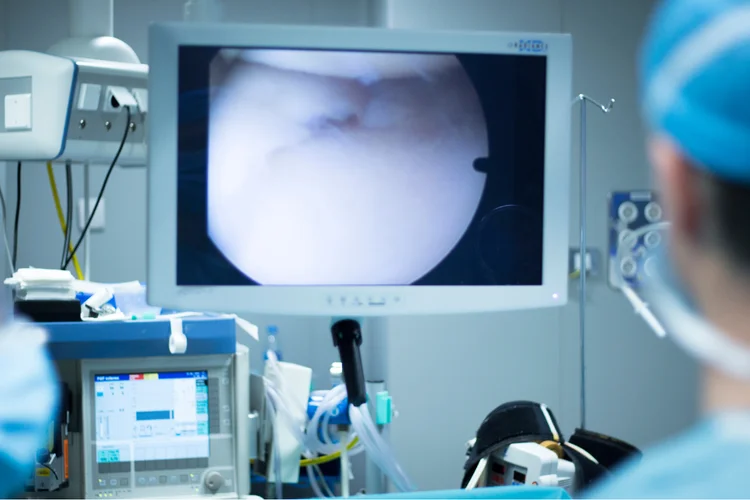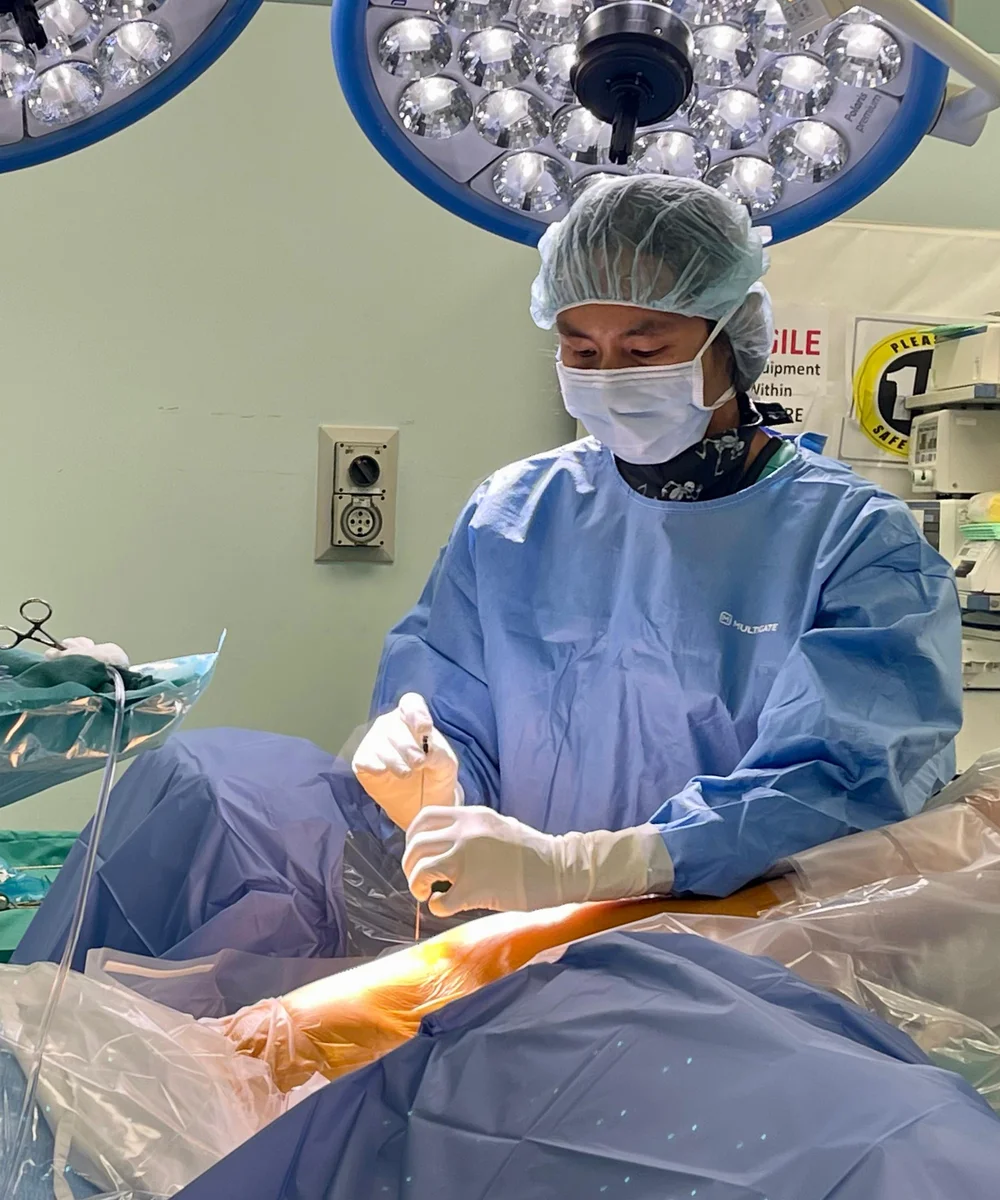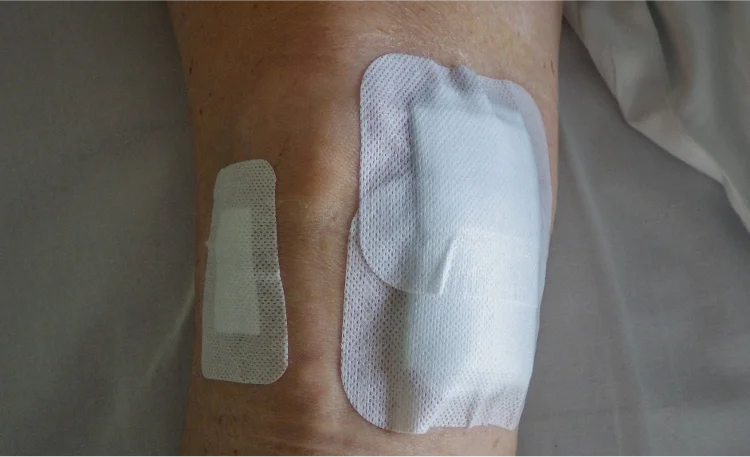Knee Arthroscopy: A Minimally Invasive Procedure for Knee Problems
Knee arthroscopy is a minimally invasive procedure to treat issues like meniscus tears, ligament injuries, and cartilage damage. Dr Foo performs arthroscopy using small incisions for faster recovery and reduced discomfort.
MBBS (University of London) | MMed (Ortho) | FRCSEd (Ortho) | FAMS (Ortho)



What Is Knee Arthroscopy?
Knee arthroscopy is a specific type of keyhole surgery used to diagnose and treat
knee joint problems. It involves inserting a small camera, known as an
arthroscope, through small incisions to provide a clear view of the knee’s structures.
The visual guide allows for precise repair or removal of damaged tissue using specialised
instruments, making it a minimally invasive alternative to open knee surgery.
Why Is a Knee Arthroscopy Performed?
Knee arthroscopy may be recommended by your specialist to diagnose and treat certain conditions such as:
- Persistent knee pain that does not improve with conservative treatments like physiotherapy, medications, or injections.
- Ligament injuries, such as anterior cruciate ligament (ACL) tears, which may require surgical intervention for stability.
- Meniscal tears, which can cause pain, swelling, and mechanical symptoms like locking or catching.
- Inflammation of the synovial lining (synovitis), leading to joint swelling and discomfort.
- Loose bone fragments or damaged cartilage, which may result from knee issues such as patellar instability or dislocation and cause pain and hinder joint movement.
Benefits of Knee Arthroscopy
Knee arthroscopy offers several advantages over traditional open surgery such as:
- Smaller Incisions – Requires only a few small incisions (usually less than an inch), reducing the risk of infection and minimising scarring.
- Less Pain and Swelling – Causes less postoperative discomfort and swelling compared to open surgery, leading to a smoother recovery.
- Faster Recovery Time – Enables a quicker return to daily activities, with physiotherapy starting soon after surgery to restore mobility, strengthen muscles, and prevent stiffness.

How Is Knee Arthroscopy Performed?
Knee arthroscopy is typically performed under regional or general anaesthesia to help ensure a pain-free and comfortable procedure.
- Incision – Two or more small incisions are made around the knee joint to allow access for the arthroscope and surgical instruments.
- Insertion of the Arthroscope – A thin, flexible tube with a high-definition camera and light is inserted into the knee. The arthroscope transmits real-time images to a monitor, enabling the surgeon to visualise the joint structures.
- Surgical Repair – Specialised miniature instruments are inserted through additional incisions to trim, repair, or remove damaged cartilage, torn ligaments, or inflamed tissue. Procedures such as meniscus repair, cartilage smoothing, or ligament reconstruction may be performed.
- Closure – Once the necessary repairs are completed, the instruments are removed. The small incisions are closed with sutures or adhesive strips and covered with sterile dressings.
The procedure typically lasts 30 minutes to an hour, depending on the specific condition
being treated and the complexity of the surgical intervention.
After surgery, patients are
monitored in the recovery area before being discharged on the same day or kept overnight if
necessary.

Recovery Time After Arthroscopic Knee Surgery
Recovery from knee arthroscopy typically takes 6 weeks to 6 months or more,
depending on the condition treated, the complexity of the procedure, and adherence to the
prescribed rehabilitation plan.
While recovery is generally faster than with open knee surgery, knee mobility and strength
must be restored gradually through physiotherapy and monitored
activity.
Typical recovery timeline:
- First Few Days – Swelling, discomfort, and stiffness are managed with ice application, leg elevation, and prescribed pain medication. Walking aids, such as crutches or a knee brace, are often required to protect the surgical site and reduce joint strain.
- 2 to 4 Weeks – Gradual reintroduction of weight-bearing activities begins under physiotherapy guidance. Exercises focus on gentle knee bending, quadriceps activation, and range-of-motion exercises.
- 4 to 6 Weeks – Physiotherapy progresses to more functional exercises to improve joint stability, muscle strength, and gait mechanics. Light activities such as walking, stationary cycling, and stair climbing may be introduced if the knee responds well.
- Beyond 6 Weeks – Further improvements in knee strength, flexibility, and mobility continue with progressive loading and functional drills. Return to high-impact activities like running or sports may take 3 to 6 months, depending on the procedure performed and recovery progress.
Following your surgeon's and physiotherapist's instructions, and avoiding excessive activity during recovery, is essential for achieving optimal long-term outcomes.
Cost of Arthroscopic Knee Surgery in Singapore
The cost of arthroscopic knee surgery varies based on factors such as the specific condition being treated and the complexity of the procedure. Below is an overview of estimated costs for various knee conditions treated with arthroscopy:
| Type of Surgery | Estimated Cost (SGD) |
|---|---|
| General Knee Arthroscopy | $10,000 – $20,000 |
| Anterior Cruciate Ligament (ACL) Reconstruction Surgery | $20,000 – $30,000 |
| Meniscus Tear Surgery | $15,000 – $25,000 |
These cost estimates generally include the surgical procedure and standard post-operative care.
However, the total cost may vary due to additional factors such as pre-surgical evaluations,
hospital stay duration, follow-up consultations, and physiotherapy sessions for rehabilitation.
Depending on the condition treated, patients can use MediSave and insurance to
offset the cost of arthroscopic knee surgery. Contact us for more information on estimated costs and
available financial options based on your specific condition.
Every patient deserves a treatment plan tailored to their needs. We start with non-surgical approaches before considering more invasive interventions.
Where Can I Find an Arthroscopic Surgeon Near Me?
Apex Novena
admin@apexsportsclinic.sg
101 Irrawaddy Rd, #18-12 Royal Square Medical Centre, Singapore 329565
Nearest MRT: NS20 Novena
Apex East Coast
admin@apexsportsclinic.sg
112 E Coast Rd, #03-03/04 i12 Katong, Singapore 428802
Nearest MRT: TE26 Marine Parade
Why Do Patients Choose Apex Sports Clinic?
Sports Doctor in Singapore: Personalised & Affordable Care
Progressive Treatment Philosophy
We prioritise personalised, non-invasive solutions, progressing to specialised treatments, including surgery, only when needed for more effective and targeted care.
Holistic Patient-Centred Care
From diagnosis to rehabilitation, we provide comprehensive and seamless care for a wide range of orthopaedic conditions.
Specialist in Sports Orthopaedics & Injury Management
We combine expert injury management with a proactive approach to maintaining your body’s strength and function, so you can recover fully and perform at your peak.
Patient Journey
1 . Schedule Your Appointment

2 . Expert Diagnosis & Consultation

3 . Customised Treatment Plan

Schedule an Appointment

Our Insurance Partners






Frequently Asked Questions (FAQs)
Recovery from knee arthroscopy varies based on the condition treated and the patient’s adherence to rehabilitation. Most people can walk with support on the same day, resume daily activities within a few weeks, and regain full knee function within three to six months. High-impact sports or strenuous activities may require a longer recovery period with a tailored physiotherapy programme.
Knee arthroscopy is considered minimally invasive surgery, not major surgery, because it involves small incisions, less tissue disruption, and a quicker recovery time compared to open knee procedures. However, the extent of surgery depends on the complexity of the knee condition being treated. While it is not classified as major surgery, it still requires proper post-operative care and rehabilitation.
Pain after knee arthroscopy is generally mild to moderate and varies from person to person. Most patients experience discomfort, swelling, and stiffness in the first few days, which can be managed with prescribed pain relief, ice therapy, and elevation. Pain levels typically decrease as the knee heals, and physiotherapy helps prevent long-term stiffness and discomfort.
Knee arthroscopy is beneficial for certain knee conditions, such as meniscal tears, ligament injuries, and cartilage damage, when conservative treatments have failed. It allows for targeted treatment with minimal disruption to surrounding tissues. However, its effectiveness depends on the severity of the condition and the patient's overall knee health, so consultation with a specialist is essential to determine if arthroscopy is the best option.
Arthroscopy is a minimally invasive procedure used to diagnose and treat knee injuries by inserting a small camera and instruments through tiny incisions. Arthroplasty, on the other hand, refers to joint replacement surgery, where damaged joint surfaces are replaced with artificial implants. Arthroscopy is generally used for minor to moderate knee injuries, whereas arthroplasty is performed for severe joint degeneration, such as in advanced osteoarthritis.
Yes, most patients can walk with the support of crutches or a knee brace on the same day after surgery. However, weight-bearing should be introduced gradually based on the surgeon’s recommendations and the specific procedure performed. Walking too soon without support may strain the knee and delay recovery.
Knee bending is usually encouraged gradually after surgery to prevent stiffness and restore range of motion. However, the extent to which you can bend your knee depends on the procedure performed and your surgeon’s instructions. Physiotherapy typically includes guided knee flexion exercises to improve movement safely.
Bilateral knee arthroscopy is minimally invasive surgery on both knees, done simultaneously or separately. It treats meniscal tears, cartilage damage, or other joint issues in both knees. Recovery may take longer than a single-knee procedure and requires a structured rehabilitation plan. If you are experiencing persistent issues in both knees, consult an orthopaedic specialist to determine if the procedure is suitable for your condition.
Knee arthroscopy may not be recommended for advanced osteoarthritis or severe joint degeneration, where the cartilage is extensively worn down. For some degenerative conditions, non-surgical treatments such as physiotherapy or knee replacement surgery may provide better long-term outcomes. A thorough evaluation by an orthopaedic specialist can help determine the most suitable treatment.
Climbing stairs is usually possible within a few weeks post-surgery, but it should be done cautiously. Initially, patients may need to use a railing, knee brace, or crutches to minimise knee strain. It is best to follow your surgeon’s or physiotherapist’s guidance to ensure a safe and gradual return to normal activities.
Persistent pain three months post-surgery may be due to factors such as incomplete healing, scar tissue formation, underlying joint degeneration, or inadequate rehabilitation. If pain persists, it is important to consult your orthopaedic specialist for further assessment, as additional physiotherapy or treatment may be needed.
The cost of knee arthroscopy in Singapore varies depending on the complexity of the procedure and the condition being treated. General knee arthroscopy costs between $10,000 – $20,000, while procedures like ACL reconstruction range from $20,000 – $30,000, and meniscus repair can cost $20,000 – $25,000. Patients can use MediSave and insurance to offset part of the cost.
While knee arthroscopy is minimally invasive, potential downsides include postoperative stiffness, swelling, and the risk of persistent pain if the underlying condition is not fully addressed. Additionally, not all knee conditions benefit from arthroscopy, particularly severe osteoarthritis or extensive cartilage loss. As with any surgery, risks such as infection and blood clots are possible, though rare.
Most patients need a few days of rest before gradually resuming light activities. Full weight-bearing is typically introduced within two to six weeks, depending on the specific procedure. High-impact activities should be avoided until cleared by the surgeon, which can take several months.
Arthroscopy is a minimally invasive procedure using small incisions and a camera to treat knee conditions. Arthrotomy is an open surgical approach where a larger incision is made to directly access the joint, usually for more complex repairs or joint replacements. Arthroscopy typically results in faster recovery compared to arthrotomy.
MRI is a non-invasive imaging tool that helps diagnose knee conditions, whereas arthroscopy allows direct visualisation and treatment of joint problems. Arthroscopy is superior in cases where MRI findings are inconclusive or when a repair procedure is needed. However, MRI is often used as the first step to assess knee injuries before considering surgery.
Knee arthroscopy is suitable for individuals with meniscal tears, ligament injuries, cartilage damage, or loose bone fragments causing pain and impaired function. Patients with mild to moderate knee issues unresponsive to conservative treatments may benefit. However, those with severe osteoarthritis or extensive joint degeneration may need alternative treatments. A specialist consultation can determine if the procedure is right for you.
Postoperative pain can persist due to inflammation, scar tissue formation, or unresolved knee pathology. If pain continues beyond the expected recovery period, further evaluation or physiotherapy may be needed to rule out complications or incomplete healing.
Severe pain is not typical after knee arthroscopy but can occur due to swelling, excessive joint stress, or complications such as infection or blood clots. If severe pain persists, immediate medical attention is recommended to identify the cause and provide appropriate treatment.
Showering is usually allowed after 24 to 48 hours, but the incisions must be kept dry until fully healed. Waterproof dressings can be used to protect the surgical site, and patients should follow their surgeon’s specific instructions on wound care.
Recovery exercises typically include gentle knee bending, quadriceps strengthening, straight leg raises, and ankle pumps to improve circulation and prevent stiffness. Following your prescribed physiotherapy programme is essential to restore function, strengthen the knee, and prevent long-term weakness.
Arthroscopy is not always recommended for osteoarthritis, especially in advanced cases with extensive cartilage damage. However, it may help remove loose cartilage or bone fragments that cause symptoms like locking or catching. Patients with severe osteoarthritis may benefit more from non-surgical treatments or knee replacement surgery. It is best to consult with an orthopaedic surgeon to determine the best treatment for your condition.

